The History of the Vivian G. Harsh Society
Summary
In 1994 a group of scholars, professionals, and community activists formed a committee to investigate what had happened to the remaining $84,000 of the $435,000 allocated by the Build Illinois Program to purchase land to house the Vivian G. Harsh Collection. The group was aware of the poor state of the Collection and concerned that this archive of Afro-American literature, art, and historical documents started by the city’s first Black librarian would not survive.
More than 20 strong, the committee petitioned city officials to invest the promised funds to build a new space for the Vivian G. Harsh Collection at the Woodson Regional Library. The press, particularly The Chicago Defender, adopted the issue and sparked community and citywide support. The committee officially became the Society for the Advancement of the Vivian G. Harsh Research Collection of Afro-American History and Literature.
In 1995, city and state officials announced a $3.5 million renovation project to expand and update the building housing the Harsh Collection. The Society closely monitored the construction and was forced to reopen its public action campaign to make sure the original agreement was not altered. In 1999, the new home of the Vivian G. Harsh Collection opened with a permanent exhibit gallery, expanded reading room, and preservation facilities.
Renamed the Vivian G. Harsh Society, Inc., the organization is a 501(c)(3), not-for-profit that supports the same mission as the founding 1994 committee: preserve, expand, and promote the Collection.
Projects and Goals
The Harsh Research Collection is a unit of the Chicago Public Library. The Society obtains grant support, provides supplementary funds, and donates staff to assist the Collection to:
- Purchase equipment that provides public access to audio-visual holdings.
- Purchase and solicit books to strengthen and keep the Collection.
- Convert rare oral histories from deteriorating audio tapes to more permanent formats and transcriptions.
- Assist, support and publicize exhibits.
Past Exhibits and Programs
- Brown v. Board of Education
- Medical History
- Chicago's Black Writers and Publishers
- Harsh 75th Anniversary
- Looking Back Moving Forward
- The Chester Commodore Exhibit, the Marion Perkins Exhibit
- Samella Lewis joint lecture and exhibit with the South Side Community Art Center
We invite and encourage you to support these and other efforts to preserve and promote Black History. We would welcome your membership in the Vivian G. Harsh Society!
History
The Vivian G. Harsh Collection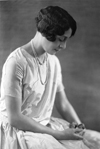 Vivian G. HarshMost people don’t know that, on the South Side of Chicago, the Carter G. Woodson Regional Library, at 95th and Halsted Streets, houses the Vivian G. Harsh Research Collection of Afro-American History and Literature (VGHC), the largest research collection of documents pertaining to Black history and culture in the Midwest. It is used by researchers, writers, and scholars from all parts of the world. The collection holds more than 70,000 books (many of them rare), over 500 current and retrospective periodical titles, a 100 microfilm research collection (totaling more than 6,000 reels), nearly 50,000 photographs, and more than 150 manuscript and archival collections. The original manuscript collections include materials from the likes of novelist Richard Wright, sociologist Horace R. Cayton, community activist Timuel Black, writer/ historian Arna Bontemps, Era Bell Thompson, and Cyrus Colter. Two important publishers, Heritage Press and Path Press are also collected here.
Vivian G. HarshMost people don’t know that, on the South Side of Chicago, the Carter G. Woodson Regional Library, at 95th and Halsted Streets, houses the Vivian G. Harsh Research Collection of Afro-American History and Literature (VGHC), the largest research collection of documents pertaining to Black history and culture in the Midwest. It is used by researchers, writers, and scholars from all parts of the world. The collection holds more than 70,000 books (many of them rare), over 500 current and retrospective periodical titles, a 100 microfilm research collection (totaling more than 6,000 reels), nearly 50,000 photographs, and more than 150 manuscript and archival collections. The original manuscript collections include materials from the likes of novelist Richard Wright, sociologist Horace R. Cayton, community activist Timuel Black, writer/ historian Arna Bontemps, Era Bell Thompson, and Cyrus Colter. Two important publishers, Heritage Press and Path Press are also collected here.
 George Cleveland HallWhere did this stunning collection come from and how did it get to 9525 South Halsted? It actually began when Vivian Gordon Harsh, the first Black librarian in the City of Chicago, began collecting rare books and documents during the 1920s with little help, but much resistance, from the Chicago Public Library’s (CPL) administrators. By the 1930s, she had the basis for what would come to be called “The Special Negro Collection.” Also, in the 1920s, George Cleveland Hall, then Chief of Staff at Provident Hospital and one of the founding members of the Association for the Study of Negro Life (ASNL), began to spur the CPL system to open a branch in the expanding and enterprising Black South Side community, later to be called “Bronzeville.” However, it was not until after Hall’s death that a library was built in 1932. Fittingly, this facility, at 48th Street and Michigan Avenue, was named in Hall’s honor.
George Cleveland HallWhere did this stunning collection come from and how did it get to 9525 South Halsted? It actually began when Vivian Gordon Harsh, the first Black librarian in the City of Chicago, began collecting rare books and documents during the 1920s with little help, but much resistance, from the Chicago Public Library’s (CPL) administrators. By the 1930s, she had the basis for what would come to be called “The Special Negro Collection.” Also, in the 1920s, George Cleveland Hall, then Chief of Staff at Provident Hospital and one of the founding members of the Association for the Study of Negro Life (ASNL), began to spur the CPL system to open a branch in the expanding and enterprising Black South Side community, later to be called “Bronzeville.” However, it was not until after Hall’s death that a library was built in 1932. Fittingly, this facility, at 48th Street and Michigan Avenue, was named in Hall’s honor.
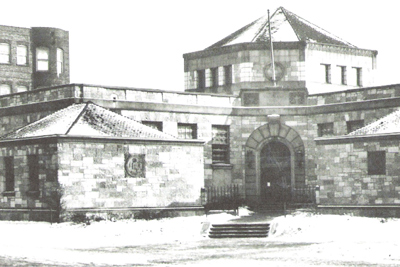 Hall Branch LibraryIn 1932, Vivian G. Harsh was named head librarian of the Hall Branch Library, and began establishing the “Special Negro Collection”, which became an integral part of its community service. Expansion was rapid because of donations of books, pamphlets, and rare materials from scholars and community activists. Funds for collection expansion were also provided by the Rosenwald Foundation, from donations made by supportive patrons, and from Harsh’s own pockets. As the collection expanded throughout the 30s and 40s, it faced continuous opposition from CPL’s administration. This pattern was established and continues today.
Hall Branch LibraryIn 1932, Vivian G. Harsh was named head librarian of the Hall Branch Library, and began establishing the “Special Negro Collection”, which became an integral part of its community service. Expansion was rapid because of donations of books, pamphlets, and rare materials from scholars and community activists. Funds for collection expansion were also provided by the Rosenwald Foundation, from donations made by supportive patrons, and from Harsh’s own pockets. As the collection expanded throughout the 30s and 40s, it faced continuous opposition from CPL’s administration. This pattern was established and continues today.
The reputation of the collection grew rapidly and the library became the meeting place for young Black writers and artists. Harsh’s “Book Review and Lecture Forum” regularly featured a cluster of speakers who would become world famous, such as Zora Neal Hurston, Richard Wright, Langston Hughes, and Margaret Walker. By the ‘50s, the collection was considered one of the leading Black history research institutions in the country.
When Vivian Harsh retired in 1958, the collection languished as parts of it were relegated to the basement and irreplaceable pieces “disappeared.” The rise of the Civil Rights Movement and a renewed consciousness of Black history led to several government grants to acquire new materials. In 1970, the collection was fittingly renamed the Vivian G. Harsh Collection of Afro-American History and Literature. It was decided in 1975 to move the collection to the newly constructed Carter G. Woodson Regional Library. Here, the VGHC underwent stupendous growth to 30,000 volumes in 1986 and to 70,000 volumes by 1993.
As the collection grew and became world renowned (along with the Schomburg Center in NYC, the Moorland-Spingarn Collection in Washington, D.C., and the Fisk University Special Collection), the space accommodations and preservation facilities did not keep pace. Many of the aged papers were deteriorating because of improper climate settings and space. And, what was not deteriorating was in jeopardy of being stolen due to the lack of proper security.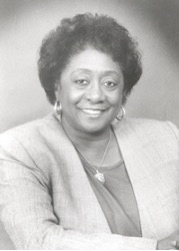 Monique D. DavisWoodson is in the district of State Rep. Monique D. Davis (D-27), and the deteriorating conditions were made known to the then-Alderwoman Davis, by Hattie Power, a former library director. In 1989, Davis spearheaded a bill that resulted in $435,000 being allocated by the Build Illinois Program for the purchase of land to house the Vivian G. Harsh Collection. The State of Illinois appropriated the nearly one-half million dollars to enable the Chicago Public Library to purchase land, hire an architectural firm, and clear the site for a new facility. The money remained unspent for two years, until it was reappropriated from the Illinois Civic Center Bond Fund in March of 1991. Nearly half of the money ($200,000) was diverted to replace a badly leaking roof at the Woodson Library. From the remaining funds of $97,300, an additional $13,000 was expended for the purchase of the property at the corner of Emerald and 95th Street, which would be the future home of the collection. Earlier, in December of 1990, at the 15th anniversary of the Woodson Library, the then-CPL Commissioner, John Duff, announced that the city was committed to constructing a new facility on the site. A facility building plan was requested from the curator of the Harsh Collection, Robert Miller, in March of 1991. The plan was filed two months later. However, no further movement, by either the city or the state, took place until 1994.
Monique D. DavisWoodson is in the district of State Rep. Monique D. Davis (D-27), and the deteriorating conditions were made known to the then-Alderwoman Davis, by Hattie Power, a former library director. In 1989, Davis spearheaded a bill that resulted in $435,000 being allocated by the Build Illinois Program for the purchase of land to house the Vivian G. Harsh Collection. The State of Illinois appropriated the nearly one-half million dollars to enable the Chicago Public Library to purchase land, hire an architectural firm, and clear the site for a new facility. The money remained unspent for two years, until it was reappropriated from the Illinois Civic Center Bond Fund in March of 1991. Nearly half of the money ($200,000) was diverted to replace a badly leaking roof at the Woodson Library. From the remaining funds of $97,300, an additional $13,000 was expended for the purchase of the property at the corner of Emerald and 95th Street, which would be the future home of the collection. Earlier, in December of 1990, at the 15th anniversary of the Woodson Library, the then-CPL Commissioner, John Duff, announced that the city was committed to constructing a new facility on the site. A facility building plan was requested from the curator of the Harsh Collection, Robert Miller, in March of 1991. The plan was filed two months later. However, no further movement, by either the city or the state, took place until 1994.
The Vivian G. Harsh Society, Inc.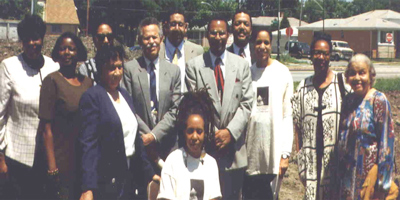 What has become know as the Vivian G. Harsh Society, Inc. started out in April of 1994, when a committee was formed to find out what became of the remainder of the allocated monies and to press for additional funds for the actual construction of an adequate facility to house the collection. Dr. Aldon Morris, co-chair (Dr. B.J. Bolden was the other) of the Planning Committee, said that the group was formed because of the awareness of the poor state of the Harsh Collection on the part of a number of scholars and concerned citizens. Concern also for the future of the collection illustrated the need for an organized group to publicize to the city and the community what was not happening and to come up with solutions. The group, over 20 strong, included a broad spectrum of people—physicians, attorneys, scholars, community activists, and educators.
What has become know as the Vivian G. Harsh Society, Inc. started out in April of 1994, when a committee was formed to find out what became of the remainder of the allocated monies and to press for additional funds for the actual construction of an adequate facility to house the collection. Dr. Aldon Morris, co-chair (Dr. B.J. Bolden was the other) of the Planning Committee, said that the group was formed because of the awareness of the poor state of the Harsh Collection on the part of a number of scholars and concerned citizens. Concern also for the future of the collection illustrated the need for an organized group to publicize to the city and the community what was not happening and to come up with solutions. The group, over 20 strong, included a broad spectrum of people—physicians, attorneys, scholars, community activists, and educators.
In 1994, these local scholars, professionals, and community activists, committed to preserving the legacy of African American history and literature for future generations, began petitioning city officials to invest the promised funds toward renovating the Woodson Regional Library by providing new space for the Vivian G. Harsh Collection. The press, particularly The Chicago Defender, picked up on the issue and helped to spark more community and citywide support. In this same year, the committee formed the Society for the Advancement of the Vivian G. Harsh Research Collection of Afro-American History and Literature.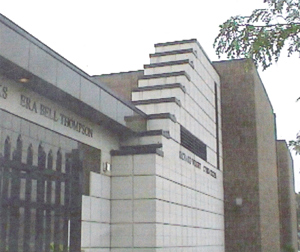 Harsh Collection New AdditionMembers of the Committee succeeded in their quest for an enhanced facility. In 1995, city and state officials announced they would begin a $3.5 million renovation project to expand and update the building housing the Hash Collection. Ground was broken for the new addition on June 17, 1996, at the 95th and Emerald site. Three years of construction work followed with the Vivian G. Harsh Society keeping close watch on all aspects of the project. In the midst of construction, the Society was forced to reopen its public action campaign in order to ensure that the original agreement was not altered. In 1999, the new home of the Vivian G. Harsh Collection officially opened to the public with a permanent exhibit gallery, an expanded reading room, preservation facilities, and excellent fire and theft protection.
Harsh Collection New AdditionMembers of the Committee succeeded in their quest for an enhanced facility. In 1995, city and state officials announced they would begin a $3.5 million renovation project to expand and update the building housing the Hash Collection. Ground was broken for the new addition on June 17, 1996, at the 95th and Emerald site. Three years of construction work followed with the Vivian G. Harsh Society keeping close watch on all aspects of the project. In the midst of construction, the Society was forced to reopen its public action campaign in order to ensure that the original agreement was not altered. In 1999, the new home of the Vivian G. Harsh Collection officially opened to the public with a permanent exhibit gallery, an expanded reading room, preservation facilities, and excellent fire and theft protection.
The Committee that began as a support mechanism to obtain a new facility for the Harsh Collection has continued to the present with many of the same people who began the struggle. The Vivian G. Harsh Society, Inc., is now a 501(c)(3), non-profit organization with the same mission that it had from the beginning — preservation, expansion, and publicizing of the collection and it programs.
Join the Vivian G. Harsh Society today!



